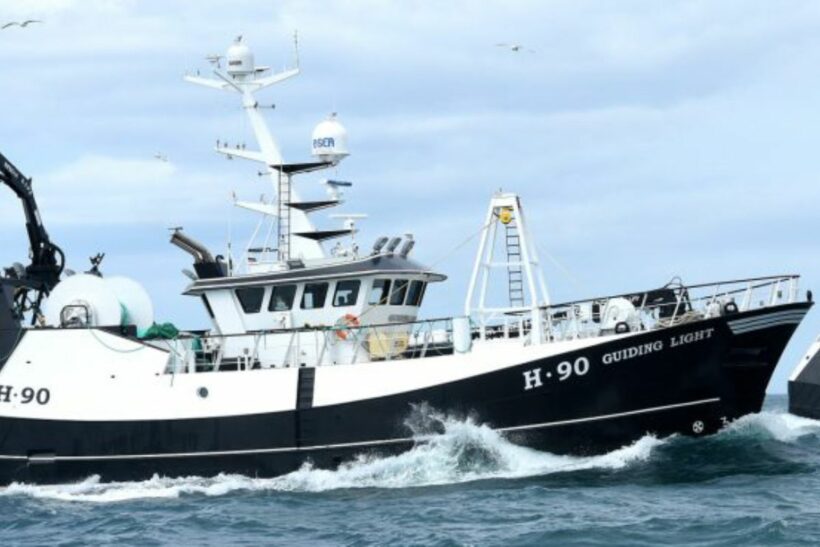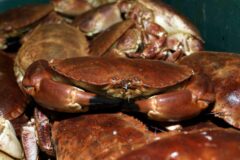Loss of Guiding Star following collision during fish transfer attributed to unattended wheelhouse on partner vessel
The Marine Accident Investigation Branch (MAIB) has released its report into the collision between two Peterhead-based pair trawlers that resulted in the sinking of one of the vessels.
The report – the purpose of which is not to attribute fault or blame – says that at approximately 11.49am on 6 October, 2022, the pair trawlers Guiding Star H 360 and Guiding Light H 90 collided in rough seas 33nm southeast of Fair Isle (FN, 20 October, 2022, ‘Guiding Star owner gives thanks for crew rescue’).
The collision happened as the codend of the Guiding Star’s net was being transferred to Guiding Light. On feeling a ‘minor impact’, the skipper of the 26m Guiding Star proceeded to the aft compartment to assess the damage, where he found water pouring in behind the cabin panelling.
Despite the efforts of the crew to alleviate the flooding with the use of bilge pumps, the water level continued to rise. At 12.04pm, the skipper transmitted a Mayday call and instructed his crew to gather immersions suits and lifejackets.
The report says that two deckhands went into the cabins to collect the survival equipment, but that one became trapped. The other deckhand forced the door open, and they both exited via the emergency escape hatch – but without the survival equipment.
Meanwhile, on realising that the portable salvage pump would not cope with the continued water ingress, Guiding Star’s engineer launched the vessel’s liferaft, and the skipper gave the order to abandon ship.
With the crew of the sinking vessel unable to access their lifejackets and immersion suits, safety equipment from Guiding Light was transferred to the stricken vessel, whose crew donned the gear and took to the liferaft.
Guiding Light’s powerblock was used to lift two of Guiding Star’s crew onboard before a large wave capsized the liferaft. The six occupants were thrown into the water, but were able to reach and grab hold of the overturned liferaft.
Three of the six crew were recovered from the water using Guiding Light’s powerblock, with the remaining three crew being winched to safety by a Coastguard rescue helicopter and transferred to hospital. The five crew members rescued by the Guiding Light were assessed before the vessel departed the scene for Peterhead.
At 12.49pm, Guiding Star became fully submerged by the stern, with its bow in the air. The report notes that ‘the radar continued to turn as the vessel sank’.
The MAIB report concludes that the vessels collided because the skipper of Guiding Light left the wheelhouse unattended during the fish transfer – an operation which ‘had not been risk assessed’ and the success of which relied ‘solely on the receiving vessel’s skipper keeping clear of the vessel with its net in the water rather than formal control measures’. The investigation also found that the wheelhouse of the Guiding Star ‘had been left unattended for a significant time before the fish transfer’.
The report says the Guiding Light skipper ‘did not have the cognitive resources to remain focused on watchkeeping at a critical time, which led to a decision that took them away from the navigational controls and unable to intervene to prevent a collision’.
It concludes: “MAIB data indicates that unattended wheelhouses are still prevalent in the fishing industry, and the risks of not keeping a safe watch might not be fully appreciated or controlled.”
The report also notes that the Guiding Star’s crew were unfamiliar with the vessel’s survivability and had ‘neither assessed the risks posed by flooding nor developed appropriate procedures’, and that its lifejackets and immersion suits were inaccessible because they were stored in crew cabins below the waterline.
It also makes the point that industry guidance is focused ‘primarily on bilge pumping as a preventative measure to control flooding, rather than highlighting the vulnerability of fishing vessels without damage stability’.
The MAIB report praises the actions of both crews following the decision to abandon ship, and the subsequent rescue efforts by the crew of the Guiding Light. It describes the decision to equip both vessels with immersion suits as ‘commendable’, stating that it ‘significantly improved the crew’s chances of survival, and likely saved the lives of those who entered the water’.
A safety flyer to the industry highlighting the lessons to be learned from the incident can be accessed at: bit.ly4eV5lm5
The MAIB report into the accident can be found at: bit.ly/4eLsVSi
This story was taken from the latest issue of Fishing News. For more up-to-date and in-depth reports on the UK and Irish commercial fishing sector, subscribe to Fishing News here or buy the latest single issue for just £3.50 here.
Sign up to Fishing News’ FREE e-newsletter here.






